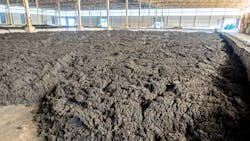New report details nation’s biosolids management
New data from the North East Biosolids and Residuals Association (NEBRA) estimates that, in a typical recent year, the U.S. uses or disposes of 5,823,000 dry metric tons of biosolids. More than half (53 percent) are treated and recycled to soils as biosolids fertilizers and soil amendments. The other 47 percent are placed in landfills or incinerated.
The report, under “The National Biosolids Data Project” (NBDP), has made available its data and supporting information at a new website created for the project.
In the U.S., more than 15,000 water resource recovery facilities (WRRFs) clean the water we use, returning it to rivers and the sea. These vital processes also provide biosolids — sewage sludges — which can be put in landfills, incinerated, or treated and tested to be recycled into soils.
The data, compiled form one representative year (2018), is comparable to the data from 2004 that NEBRA had published. The new report reveals that the rate of biosolids recycling has increased about 4 percent from the 2004 rate of 49 percent. And today, more of the highly treated Class A biosolids are being used: they account for 27 percent of biosolids used or disposed in 2018, a 5 percent higher rate than in 2004. In contrast, the rate of Class B biosolids use has declined by 5 percent. Class B biosolids have had less treatment and require more specialized management at permitted sites such as farm fields.
Notably, the new data doesn’t show many other big changes between 2004 and 2018.
“That’s somewhat of a surprise to us,” notes Janine Burke-Wells, executive director of NEBRA. “Over the past 15 years, there have been large advances and investments in how biosolids are treated and managed. Yet, the overall numbers don’t show that. You have to look into the details to see all the improvements.
NEBRA is a regional non-profit professional membership organization focused in biosolids management in New England and eastern Canada. The data project team help from the California Association of Sanitation Agencies, Northwest Biosolids, the Mid-Atlantic Biosolids Association, and Biocycle. The project saw funding from the National Association of Clean Water Agencies (NACWA), the Water Environment Federation (WEF), consulting firms, and biosolids management companies around the nation.
The new data comes form more than two years of surveys, interviews, and data compilation and analysis. For each state and for larger U.S. territories, the NBDP provides a summary of how much biosolids the state used or disposed of, how it was managed, and where it went. Each state’s story is told in data tables and a narrative summary. The project also presents nationwide totals.
Some details of biosolids use nationwide includes:
- The percentage of biosolids used for land reclamation decreased about 1 percent, while agricultural use increased about 1 percent. The percentage of incineration decreased abut 1 percent, while surface disposal increased about 1 percent.
- About half of WRRFs report that biosolids are managed by WRRF staff, while the other half have contracted haulers and land appliers.
- When biosolids are applied to soils, they are used mostly for corn for animal feed and energy, followed by hay/grass/forage. Other popular crops for biosolids fertilization are wheat and other grains, followed by Class A EQ products widely used on turfgrass (lawns, erosion control, golf courses, landscaping).
- When identifying the greatest pressures on biosolids management in 2018, WRRFs showed most concern about rising costs and future outlets for biosolids. State biosolids regulators and WRRFs said that public involvement, contaminants, and the hassles of recycling — including declining nearby farmland — were significant pressures.
- Most state regulator have significantly fewer resources dedicated to biosolids oversight in 2018 compared to 2004.
The new report includes the largest ever data set looking at the economic aspects of biosolids management. For example, surveys of WRRF biosolids programs show that the range of the average costs to have a contractor take and manage solids if about $49 per wet ton for composting, $58 for landfill disposal, $62 for land application, and more than $95 for incineration.
NBDP chose 2018 as its representative year because it was after the new U.S. Environmental Protection Agency’s sewage sludge incinerator regulations took full effect (2016) and before changes to biosolids management had occurred due to concerns about traces of rising contaminants.
“These new data provide us with a solid new baseline that biosolids professionals, researchers, and policy-makers can rely on for many years,” noted Burke-Wells. “Biosolids have to be managed, and every community has to support its WRRFs. Many are striving for greater sustainability and more circular economy by using biosolids for renewable energy and recycling them to soils.”
